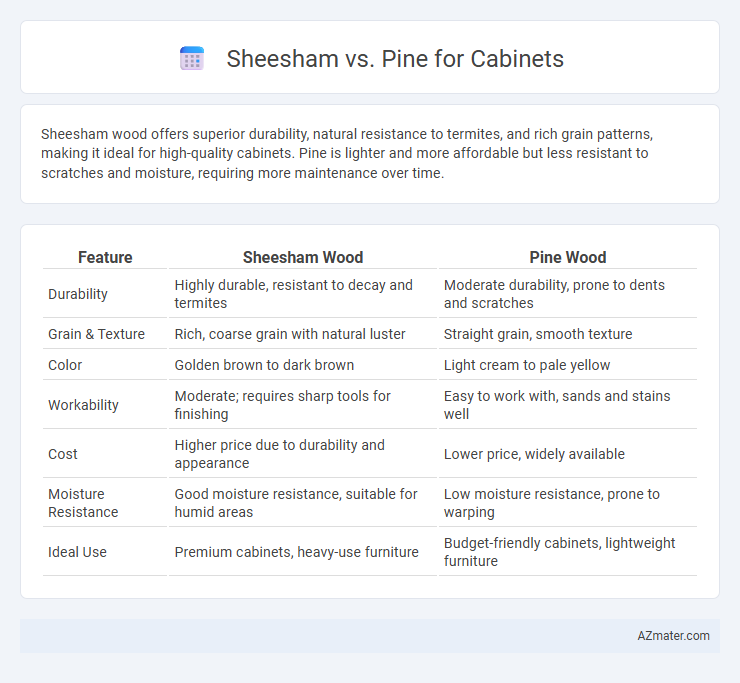Sheesham wood offers superior durability, natural resistance to termites, and rich grain patterns, making it ideal for high-quality cabinets. Pine is lighter and more affordable but less resistant to scratches and moisture, requiring more maintenance over time.
Table of Comparison
| Feature | Sheesham Wood | Pine Wood |
|---|---|---|
| Durability | Highly durable, resistant to decay and termites | Moderate durability, prone to dents and scratches |
| Grain & Texture | Rich, coarse grain with natural luster | Straight grain, smooth texture |
| Color | Golden brown to dark brown | Light cream to pale yellow |
| Workability | Moderate; requires sharp tools for finishing | Easy to work with, sands and stains well |
| Cost | Higher price due to durability and appearance | Lower price, widely available |
| Moisture Resistance | Good moisture resistance, suitable for humid areas | Low moisture resistance, prone to warping |
| Ideal Use | Premium cabinets, heavy-use furniture | Budget-friendly cabinets, lightweight furniture |
Sheesham vs Pine: An Overview
Sheesham wood, known for its rich grain and natural resistance to decay, offers enhanced durability and a luxurious appearance compared to pine. Pine, being a softwood, is lighter and more affordable but is prone to dents and scratches, making it less suitable for high-traffic cabinet use. Sheesham's higher density and naturally oily composition provide superior longevity and an elegant finish that outperforms the softer, more porous pine in cabinetry applications.
Appearance and Grain Patterns
Sheesham wood exhibits a rich, dark brown hue with distinct, intricate grain patterns that often display golden or reddish streaks, lending an elegant and luxurious aesthetic to cabinets. Pine, in contrast, features a lighter, creamy yellow to pale brown color with simpler, more uniform grain patterns marked by knots, creating a rustic and casual appearance. The complexity and depth of Sheesham's grain patterns make it ideal for high-end cabinetry, while Pine's straight grains suit more traditional or country-style designs.
Durability and Lifespan
Sheesham wood, known as Indian rosewood, offers superior durability with natural resistance to decay and insect attacks, making it ideal for long-lasting cabinets. Pine is softer and more prone to dents and scratches, requiring regular maintenance but is budget-friendly and lightweight. In terms of lifespan, Sheesham cabinets can last several decades with minimal wear, whereas pine cabinets typically have a shorter lifespan due to their susceptibility to damage over time.
Strength and Hardness
Sheesham wood is significantly stronger and harder than pine, making it ideal for durable cabinets that withstand daily wear and tear. With a Janka hardness rating of approximately 1,260, Sheesham offers robust resistance to dents and scratches compared to pine's softer rating around 420. The dense, hardwood nature of Sheesham enhances cabinet longevity, whereas pine's softer, more porous structure is prone to dents and damage under heavy use.
Cost Comparison
Sheesham wood cabinets typically cost more than pine due to their durability, rich grain patterns, and natural resistance to termites and decay. Pine is a more budget-friendly option, offering a lighter color and softer texture, but it requires more maintenance and is prone to dents and scratches. Choosing Sheesham results in a higher upfront investment but greater longevity, whereas pine serves as an economical choice for short-term or decorative cabinetry.
Maintenance and Care
Sheesham wood cabinets require regular oiling and polishing to maintain their rich texture and prevent dryness, while pine cabinets benefit from periodic sealing and gentle cleaning to avoid dents and moisture damage. Sheesham's natural oils make it more resistant to pests and rot compared to pine, which is softer and more prone to scratches and wear over time. Proper maintenance for both woods involves avoiding excessive exposure to humidity and using mild cleaning agents to preserve their finish and durability.
Environmental Impact and Sustainability
Sheesham wood, also known as Indian rosewood, is a hardwood known for its durability and resistance to pests, often sourced from sustainable plantations that promote responsible forest management. Pine is a softwood that grows faster and requires less energy for processing, making it a more renewable and eco-friendly option with a lower carbon footprint. Choosing Sheesham or Pine for cabinets depends on prioritizing long-term durability versus rapid regrowth and comparably lower environmental impact.
Versatility in Cabinet Design
Sheesham wood offers rich grain patterns and natural durability, making it ideal for intricate and ornate cabinet designs. Pine provides a lighter, softer texture that is easily stained or painted, perfect for versatile and customizable cabinetry styles. Both woods support varied design aesthetics, but Sheesham excels in longevity and elegance, while Pine is favored for affordability and ease of modification.
Resistance to Termites and Decay
Sheesham wood exhibits superior resistance to termites and decay compared to Pine, making it a more durable choice for cabinets in pest-prone environments. Its natural oils and dense grain structure provide enhanced protection against fungal attacks and insect infestation. Pine, being softer and less dense, requires chemical treatments to improve its resistance, making Sheesham a preferred option for long-lasting cabinetry.
Which Wood is Best for Cabinets?
Sheesham wood offers superior durability, rich grain patterns, and natural resistance to termites, making it an excellent choice for high-quality cabinets. Pine wood, while more affordable and lightweight, is softer and prone to dents and scratches, which may affect long-term cabinet durability. For cabinets that require strength, longevity, and an elegant appearance, Sheesham is generally considered the best option.

Infographic: Sheesham vs Pine for Cabinet
 azmater.com
azmater.com